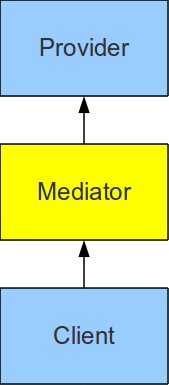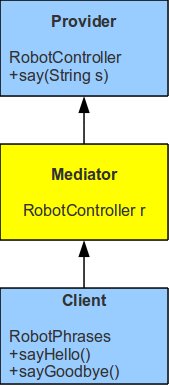CSC/ECE 517 Fall 2010/ch7 7d EC: Difference between revisions
No edit summary |
No edit summary |
||
| Line 242: | Line 242: | ||
<pre> | <pre> | ||
class SafeRobotController { | class SafeRobotController { | ||
private RobotController rc; | |||
public SafeRobotController { | |||
rc = new RobotController(); | |||
} | |||
void say(String s) { | void say(String s) { | ||
rc.say(s); | |||
} | } | ||
void walk() { | void walk() { | ||
rc.walk(); | |||
} | } | ||
void grab() { | void grab() { | ||
rc.grab(); | |||
} | } | ||
} | } | ||
Revision as of 03:18, 23 November 2010
Introduction to Design Patterns
A design pattern is a type of technique that developers use to create good software design. There are many design patterns available, and they share common benefits. The benefits of design patterns include [1] :
1. Code is more accessible and understandable.
2. Use of common vocabulary to help collaboration among developers.
3. Helps people understand the system more quickly.
4. Easier to modify system.
GRASP
GRASP stands for General Responsibility Assignment Software Patterns and consists of several design patterns for assigning responsibility and relationships between classes and objects in object-oriented design.
Some of the patterns in GRASP include Information Expert, Creator, Controller, Low Coupling, High Cohesion, Polymorphism, Pure Fabrication, Indirection, and Protected Variations [2].
In this article, we will focus on the Indirection Pattern.
The Indirection Pattern
The Indirection Pattern supports low coupling and code reuse by using a mediator object in between two objects.
A very simple diagram below illustrates the relationship between objects in the indirection pattern.

The relationship between classes in indirection pattern.
In the indirection pattern, a mediator class acts as a proxy in between the client and provider classes. The client interfaces with the mediator, not to the provider. The client accesses functionality from the provider through the mediator. Therefore, the relationship between the client and provider is indirect.
The indirection pattern is seen all of the time. Anytime the programmer accesses an API, be it for operating system call, graphics library call, the programmer is interfacing with a mediator that provides functionality on behalf of the client to some lower-level hardware functionality provided by the operating system or graphics library, etc.
A simple example of the indirection pattern is illustrated below.
Example of Indirection Pattern
Let's say we have a talking robot, and the functionality to get the robot to say a specified string has already been implemented in the code below.
class RobotController {
void say(String s) {
// Some complex code for robot to say 's'
}
}
We want to create another class that has methods to say common phrases like “hello” and “goodbye”.
class RobotPhrases {
RobotController r = new RobotController();
void sayHello() {
r.say(“Hello”);
}
void sayGoodbye() {
r.say(“Goodbye”);
}
}
In the main function, we would do the following:
public class Main {
public static void main(String[] args) {
RobotPhrases rp = new RobotPhrases();
rp.sayHello();
rp.sayGoodbye();
}
}

The RobotPhrases object instantiates a RobotController object to act as a mediator to access functionality in RobotController.
From the main class, it appears that our new RobotPhrases class has implemented the functionality to make the robot speak the specific words, when in fact, we have used a mediator object to do the work. Basically, we have passed of the duty to someone/something else [3].
Specifically, the mediator object is the RobotController r object created in the RobotPhrases that mediates the action between the two classes.
The advantage of the indirection pattern in this case, is that the RobotPhrases class is much easier to implement since we did not have to put complex, low-level robot code in the class. Also, when the speaking functionality of the robot changes, we only need to modify the say function in RobotController and not in the sayHello and sayGoodbye functions in the new class. This makes maintainability and code reuse much greater.
Another Example: Ruby on Rails
Another example of where the indirection pattern is used is the system design architecture used for web development with Ruby on Rails.
Rails uses the MVC architecture, where applications are separated into three components: model, view, and controller [4].
To briefly describe the tasks of the components [4]:
Model
Responsible for maintaining state of application. Includes data storage, generally in the form a database.
View
Provides the user interface for input and output.
Controller
Orchestrates input from view to model and provide output to view.

The MVC architecture used in Rails
Let's assume that we implement an online music store using Rails and the MVC architecture. A typical use case is illustrated below.
1. User enters http://my.url.com and view is displayed.
2. User enters “beatles” in search box.
3. Search parameter is passed to controller.
4. Controller accesses songs database in Model to search for query.
5. Model returns result to Controller.
6. Controller creates view to display results.
From this use case, the separation between view and model is illustrated. The Model does not interact with the View, and the View does not directly interact with the Model. The Controller acts as a mediator between View and Model.
The advantage of this approach is extensibility and maintainability. When View and Models are separated, they can be reused again. Whereas, if the Model and View where combined, the implementation could only be used for this application.
For example, if we wanted to create an online bookstore, we could reuse the same View components from the online music store, with some minimal changes. On the other hand, if we did not use MVC and the indirection pattern, and the View was tied in with the music Model, we probably could not easily reuse the code.
Indirection through Delegation
Indirection can also be achieved through the use of delegation.
To see this, lets assume that we are building a robot and need to implement robot functions. An existing class called RobotController already exists and has the functions we desire and then some that we don't want.

UML diagram for existing RobotController class
class RobotController {
void say(String s) {
// Some complex code for robot to say 's'
}
void walk() {
// Some complex code to walk
}
void grab() {
// Some complex code to grab nearest item
}
void selfDestruct()
// Code to self destruct robot
}
void fireWeapon()
// Code to fire weapon
}
}
The RobotController class contains all of the functionality that we desire, except we don't want selfDestruct() nor fireWeapon() methods!
One solution would be to copy over this class to create a new class, and just delete the unwanted methods. However, this involves copying over a lot of complex code, and if that code were to change, we would need to change it in the new class as well.
Another solution would be to extend this class and just override the unwanted methods with error message or simply just do nothing and return. For example, the following implementation could be done.
class SafeRobotController extends RobotController {
void selfDestruct()
// Don't want this, so just return
return;
}
void fireWeapon()
// Don't want this, so just return
return;
}
}

Extending and overriding unsafe methods in RobotController
This seems like an elegant solution, however, what happens when someone adds more functionality to RobotController such as smashObject() or becomeSelfAware(). Unfortunately, the SafeRobotController will inherit these methods.

Will SafeRobotContoller still be “safe” when the RobotController class changes to the above?
Another solution is to use indirection and not directly involve the RobotController class. Using delegation, we can isolate the class and selectively implement the desired functionality. The code below illustrates how this can be achieved.
class SafeRobotController {
private RobotController rc;
public SafeRobotController {
rc = new RobotController();
}
void say(String s) {
rc.say(s);
}
void walk() {
rc.walk();
}
void grab() {
rc.grab();
}
}
Here, the SafeRobotController instantiates a RobotController object and calls only the desired methods. Even if some evil programmer adds ill methods to RobotController, they cannot be accessed by SafeRobotController.
Essentially, we have added indirection between SafeRobotController and RobotController through the use of a mediator object.
Summary
The indirection pattern is a powerful design pattern that helps the software designer implement good design by maximizing code reuse and extensibility. In the examples shown above, indirection reduces the coupling between classes or components that are likely to change. By doing so, one could reuse or extend one component without having to affect the other.